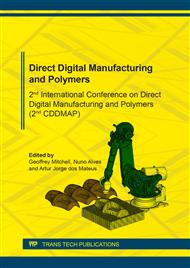[1]
J. Doshi, D.H. Reneker, Electrospinning process and applications of electrospun fibers, J. Electrostat. 35 (1995) 151–160.
DOI: 10.1016/0304-3886(95)00041-8
Google Scholar
[2]
D.H. Reneker, H. Fong, eds., Polymeric Nanofibers, American Chemical Society, Washington, DC, (2006).
Google Scholar
[3]
Z.M. Huang, Y.Z. Zhang, M. Kotaki, S. Ramakrishna, A review on polymer nanofibers by electrospinning and their applications in nanocomposites, Compos. Sci. Technol. 63 (2003) 2223–2253.
DOI: 10.1016/s0266-3538(03)00178-7
Google Scholar
[4]
J. Lee, S.H., Ku, B.C., Wang, X., Samuelson, L.A., Kumar, Design, synthesis and electrospinning of a novel fluorescent polymer for optical sensor applications, Mater. Res. Soc. Symp.– Proc (2002) 403–408.
DOI: 10.1557/proc-708-bb10.45
Google Scholar
[5]
W.E. Teo, S. Ramakrishna, A review on electrospinning design and nanofibre assemblies, Nanotechnology 17 (2006) R89–R106.
DOI: 10.1088/0957-4484/17/14/r01
Google Scholar
[6]
P.A. Mouthuy, H. Ye, 5.04 - Biomaterials: Electrospinning, Compr. Biotechnol. (2015) 23–36.
Google Scholar
[7]
H.-S. Bae, A. Haider, K.M.K. Selim, D.-Y. Kang, E.-J. Kim, I.-K. Kang, Fabrication of highly porous PMMA electrospun fibers and their application in the removal of phenol and iodine, J. Polym. Res. 20 (2013) 158.
DOI: 10.1007/s10965-013-0158-9
Google Scholar
[8]
A. Haider, S. Haider, I.-K. Kang, A comprehensive review summarizing the effect of electrospinning parameters and potential applications of nanofibers in biomedical and biotechnology, Arab. J. Chem. (2015).
DOI: 10.1016/j.arabjc.2015.11.015
Google Scholar
[9]
M.J. Laudenslager, W.M. Sigmund, Electrospinning, in: Encycl. Nanotechnol., Springer Netherlands, Dordrecht, 2012: p.769–775.
Google Scholar
[10]
S. Megelski, J.S. Stephens, D. Bruce Chase, J.F. Rabolt, Micro- and nanostructured surface morphology on electrospun polymer fibers, Macromolecules 35 (2002) 8456–8466.
DOI: 10.1021/ma020444a
Google Scholar
[11]
J. Zeleny, The role of surface instability in electrical discharges from drops of alcohol and water in air at atmospheric pressure, J. Franklin Inst. 219 (1935) 659–675.
DOI: 10.1016/s0016-0032(35)91985-8
Google Scholar
[12]
S. Zargham, S. Bazgir, A. Tavakoli, A.S. Rashidi, R. Damerchely, The Effect of Flow Rate on Morphology and Deposition Area of Electrospun Nylon 6 Nanofiber, J. Eng. Fiber. Fabr. 42 (2012) 42–49.
DOI: 10.1177/155892501200700414
Google Scholar
[13]
K.P. Matabola, Moutloali, The influence of electrospinning parameters on the morphology and diameter of poly(vinyledene fluoride) nanofibers-effect of sodium chloride, J. Mater. Sci. 16 (2013) 5475.
DOI: 10.1007/s10853-013-7341-6
Google Scholar
[14]
T. Wang, S. Kumar, Electrospinning of polyacrylonitrile nanofibers, J. Appl. Polym. Sci. 102 (2006) 1023–1029.
DOI: 10.1002/app.24123
Google Scholar
[15]
S. Haider, Y. Al-Zeghayer, F.A. Ahmed Ali, A. Haider, A. Mahmood, W.A. Al-Masry, M. Imran, M.O. Aijaz, Highly aligned narrow diameter chitosan electrospun nanofibers, J. Polym. Res. 20 (2013) 105.
DOI: 10.1007/s10965-013-0105-9
Google Scholar
[16]
N. Zander, N. E., Hierarchically Structured Electrospun Fibers, Polymers (Basel). 5 (2013) 19–44.
Google Scholar
[17]
H. Fong, I. Chun, D.H. Reneker, Beaded nanofibers formed during electrospinning, in: Polymer (Guildf)., 1999: p.4585–4592.
DOI: 10.1016/s0032-3861(99)00068-3
Google Scholar
[18]
B. Sun, Y.Z. Long, H.D. Zhang, M.M. Li, J.L. Duvail, X.Y. Jiang, H.L. Yin, Advances in three-dimensional nanofibrous macrostructures via electrospinning, Prog. Polym. Sci. 39 (2014) 862–890.
DOI: 10.1016/j.progpolymsci.2013.06.002
Google Scholar
[19]
R. Krishnamoorti, I. Banik, L. Xu, Rheology and processing of polymer nanocomposites, Rev. Chem. Eng. 26 (2010) 3–12.
Google Scholar
[20]
T.J. Sill, H.A. von Recum, Electrospinning: Applications in drug delivery and tissue engineering, Biomaterials 29 (2008) 1989–(2006).
DOI: 10.1016/j.biomaterials.2008.01.011
Google Scholar
[21]
S. Huan, G. Liu, G. Han, W. Cheng, Z. Fu, Q. Wu, Q. Wang, Effect of Experimental Parameters on Morphological, Mechanical and Hydrophobic Properties of Electrospun Polystyrene Fibers, Materials (Basel). 8 (2015) 2718–2734.
DOI: 10.3390/ma8052718
Google Scholar


